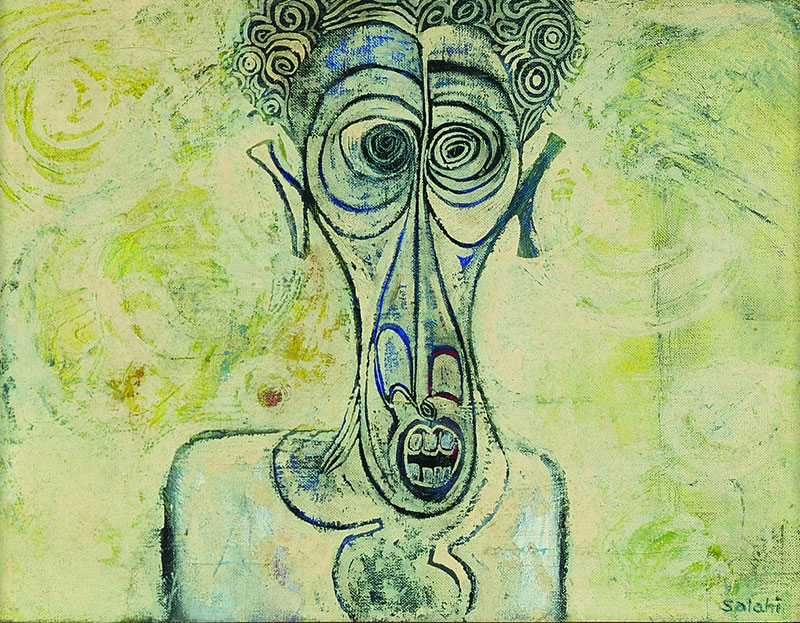
With 218 artists from more than 60 countries, Postwar is big – although its size hardly compares to the inaugural exhibition at the Haus der Kunst 80 years earlier. Hitler’s pet project, the Great German Art Exhibition had nearly three times as many works, more than twice the artists and double the floor space. The Great German Art Exhibition is barely remembered today except for its deficiencies, but it is a precursor to Postwar and in more ways than Okwui Enwezor – chief curator and director of the Haus der Kunst – acknowledges. Both display a certain nerve and ambition. In his opening speech Hitler declared: “The exhibit itself must bring about a turning point”.[1] That turning point was decisively against the discourse of modernism, an objective shared by Enwezor.
But after the war modernism’s discourse was very different from before. In commemorating the heroic struggle that began in the creative surge of those Hitler labeled “degenerate” and ending with its apotheosis in New York, modernism became a monument to the ascendency of Western liberalism and the free world, and ipso facto, Hitler’s abysmal failure. So complete was Hitler’s downfall that his vision and the art he championed have been expunged from the history of twentieth-century art. By contrast, Hitler’s shadow looms over Postwar. Thus he is made a symptom not an aberration of Western civilization. Rather than telling the tale of Western liberalism’s triumph, Postwar narrates its failure and dissolution in the currents of late modernism. Its thesis – the war instigated a rupture that the discourse of modernism obscures in the name of Westernism – forcefully announces an alternative modernism.
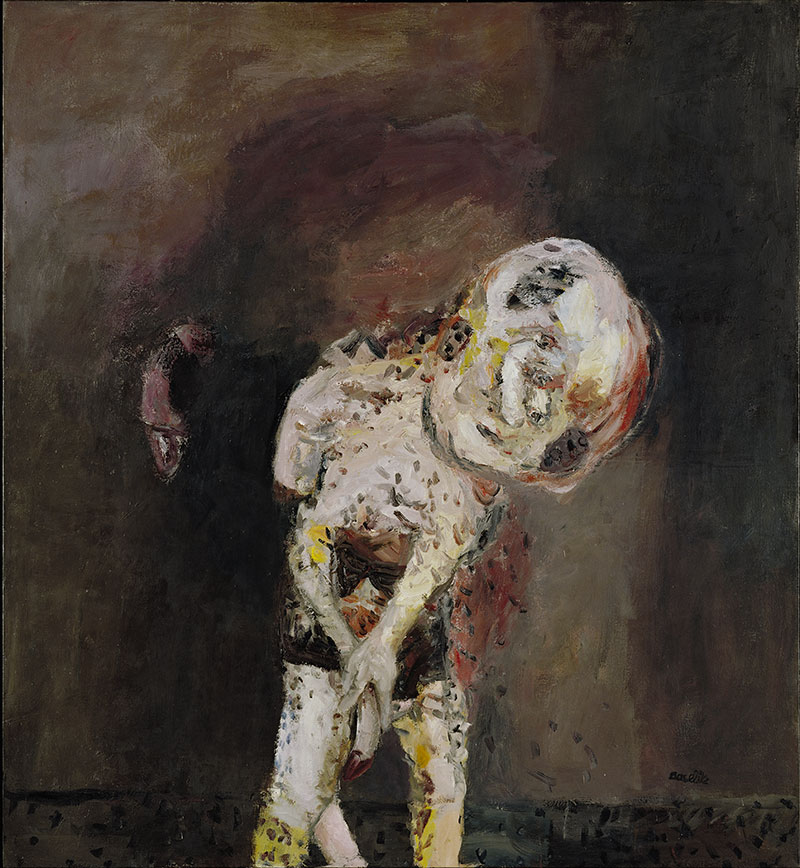
Postwar’s curatorial team also includes Katy Siegel and Ulrich Wilmes. They bring a depth of knowledge about postwar Western art that forms the trunk of the exhibition. But the white-anting of this stump is the real aim of Postwar. Nearly 70% of the art on display was made in Western centres, mainly New York, London and Paris, but much of it is the work of the postcolonial diaspora. At stake in this reappraisal of late modernism are big and urgent questions about ancestors, inheritances, investments, agency, fields of struggle, geographies of power and modes of temporality.
Postwar picks up the concerns of Enwezor’s groundbreaking exhibition, The Short Century (2001): it is a genealogy of our era, but one that has widened from Africa to the globe, and narrowed from fifty to twenty years. Genealogical research, which thinks the present through its ancestry, requires a time machine. Enwezor is the artworld’s Dr Who, rewiring the past in order to redistribute its inheritance and at the same time establish a credible history of contemporary art’s cosmopolitan globalism.
In putting so many non-Western artworks in conversation with mainstream Western modernism, Postwar emphatically demonstrates that the Western artworld failed to see the transcultural ground upon which it walked. Thus Postwar complicates the artworld myths of the New York School through which the West reinstated its cultural hegemony after the war. By implication, it also casts doubt on the myths of 1968 and 1989 with which the West maintained its cultural leverage in the face of globalisation. Postwar declares that the writing was already on the wall. With its political, cultural and moral authority shattered by two world wars, during the brief twenty years after 1945 Europe’s empires disintegrated and a new post-Western future was imagined.
.jpg)
Postwar will be viewed as groundbreaking for another reason: it is the first historical exhibition of world art. World art has been the province of the art biennales that proliferated after 1990. While their focus has rarely been historical, Postwar has the feel of a biennale, in which bigger really is better, and in which sheer quantity – over 300 artworks plus copious didactic material – is beyond the power of any one mind to process, at least in the average time span one spends in an exhibition.
The massive 850-page brick of a catalogue is another sign of this Society of the Spectacle. And like many biennales, Postwar also comes with a smaller user-friendly “Exhibition Guide” – a mere 320 pages – which provides a short commentary on each artwork. If, as I argue, Postwar resists the sublime promise of the spectacle’s totalising perspective, the verdict of many viewers will undoubtedly be that it has succumbed to the curse of Babel. To survive Postwar requires leaving behind traditional blockbuster expectations of being swept away in rapture.
Postwar is an historical exhibition but it is not organised chronologically or tethered to the teleology of either style or individual artistic development. Rather, it is historical in the larger sense of positioning the art in relation to social and political events, such as Hiroshima, the Holocaust, the Cold War and anti-colonial wars, decolonisation and related the civil rights movements and the development of new instruments of circulation. Thus it is a history of relations of production, not art or artists.
Because there are 218 artists in the exhibition, it couldn’t be an exhibition about individual artists and their intentions, styles etc. Its very scope required it to be an exhibition about tendencies. Eight themes map the various ways in which artists sought to rethink the purpose of art and life, to find new images of humanity and governance, to rejuvenate language by returning to its formal constituents or the material properties of things, and to establish new cosmologies generally based on a post-apocalyptic ontology.
.jpg)
This thematic organisation is the least convincing aspect of the exhibition. The opening theme, “Aftermath: Zero Hour and the Atomic Era”, successfully sets you on your way but thereafter the themes lose relational coherence. For example, “Nations Seeking Form” explores the pervasive but ambivalent role of nationalism during the period, but we are left little the wiser. How, I wanted to know, did it relate to the adjacent theme “Cosmopolitan Modernisms”? Rather than providing a convincing conceptual structure, the thematic sections are like disparate battlefronts onto which the larger cataclysm always intrudes.
The exhibition’s focus is work made by artists who came of age during the war and immediately afterwards. The war’s impact is largely understood in terms of its scale, which Postwar measures in terms of geography (the war’s global reach), the sheer magnitude of the Holocaust and other civilian deaths (est. 55 million, mostly Russian and Chinese), the saturation bombing of major cities in Germany and Japan, and nuclear annihilation of Hiroshima and Nagasaki. This unprecedented enormity provoked resistance to its spectacle, triggering existential questions that challenged received beliefs about the origins and ends of humanity and art.
As if needing to find a form true to the savage spectacle of the war, Postwar engages in its own saturation bombing and spectacle. But while inundated with art and documents, shelter is found in its many side alleys. Here, face-to-face with the art, resistance arises. The art is primarily painting and sculptural, from a monumental scale to small works on paper. It includes well-known, lesser- known and unknown “masterpieces”, as well as work that surely only made the cut because of its subject matter or title. But whatever one’s judgements, the work generally exhibits a type of anti-aesthetic. So many seem to bear the scars of some post-apocalyptic afterlife – “art in extremis” – as if its makers were reeling from some psychic shock.
.jpg)
This anti-aesthetic is also evident in the exhibition’s curation. While the curators at times gesture towards traditional categories of style – for example, abstraction versus realism – the overall effect is to muddy the stylistic categories by which art historians have retrospectively ascribed order to this period. Nevertheless, the exhibition has a definite period style – grunge would be an appropriate label. There is a deliberate untidiness and crowding, the cumulative effect of which echoes the emotion of the time – a sense of collapse, incomprehension and abjection. Thus the distantiation of aesthetic contemplation that reigns in the usual narration of late modernism is curtailed. In the clamorous Postwar, even the iconic masterpieces of Pollock, Warhol and Rauschenberg – now familiar commodities in the world’s elite museums – are plunged into a whirlpool of ideas. So, too, is the viewer: you either sink or swim.
The layout and huge ceilings of the galleries add to the viewer’s plight. A large central hall is surrounded on all sides by eleven smaller rooms within which one is easily lost. The addition of more walls to increase hanging space further disorientates. Crammed with things, it looks more like the discordant Degenerate Art exhibition initiated by Goebbels, than the orderly Great German Art Exhibition, conceived as its dialectical other and which opened at the same time just a stone’s throw away.
The open airy galleries of the Great German Art Exhibition made its space a free sublime medium through which you could move as if master of the place, but in the spatial disorientation of Degenerate Art and Postwar the viewer is subject to a bewildering array of signifying relations, a carnival of signs that only a Lévi-Strauss could decode.
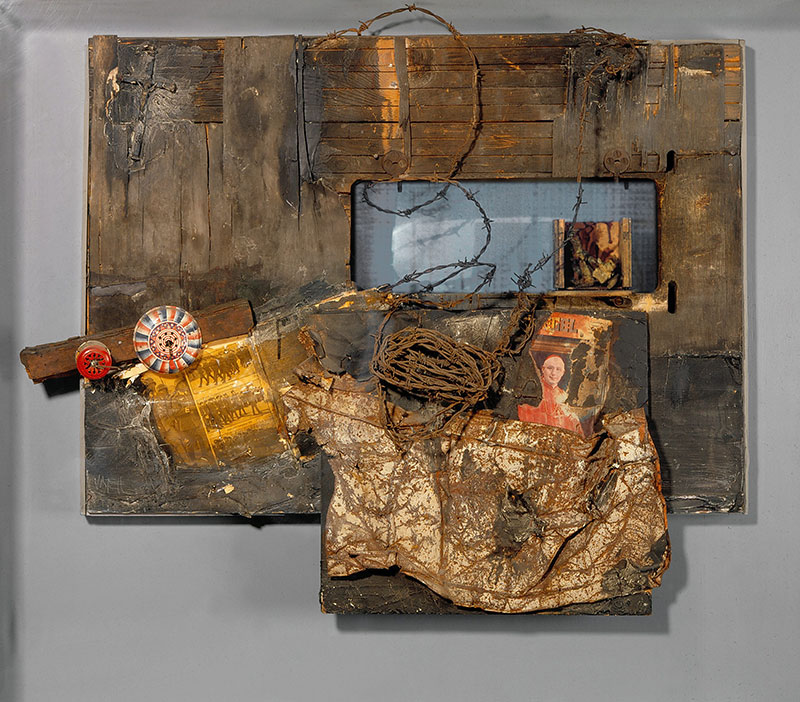
This bricolaging is so pervasive that its curatorial intent cannot be ignored. Its tumult demands the viewer be a participant in an immanent Darwinian field of ceaseless struggle. To survive you must discern the structure or rules that put the different elements in play. In this respect, the exhibition operates (or doesn’t) room by room, across and between walls.
Here, in the thick of it, the participatory commotion of the public sphere refuses the transcendant spectacle it confronts. “Form Matters”, the title of the second theme, is the secret to surviving Postwar. This is the lesson of the first and last work you encounter, Joseph Beuys’s Hirschdenkmaler (Monuments to the Stag), an assemblage of about 40 rudimentary objects scattered across the floor. Postwar is also an assemblage in which meaning is produced through the relations it puts into play. These relations transform things into signs, thereby giving them speech and creating conversations.
Hirschdenkmaler also announces the temporal logic of the exhibition: that the future is in the past and the past is in the future. First conceived in 1982, it is well outside the timeframe of Postwar. One element was made in 1958: the stag – a bricolage/assemblage comprising an ironing board balancing on two logs that straddle four tree stumps. Since its form first appeared on the walls of Ice Age caves and in ancient myths, the stag has symbolised regeneration, the cycle of life. It is Beuys’s emblem of the postwar desire for new beginnings; but it is also an emblem of temporality geared to ancestry not Hitler’s futurism of a “new human type” that is “stronger and more beautiful”.[1]
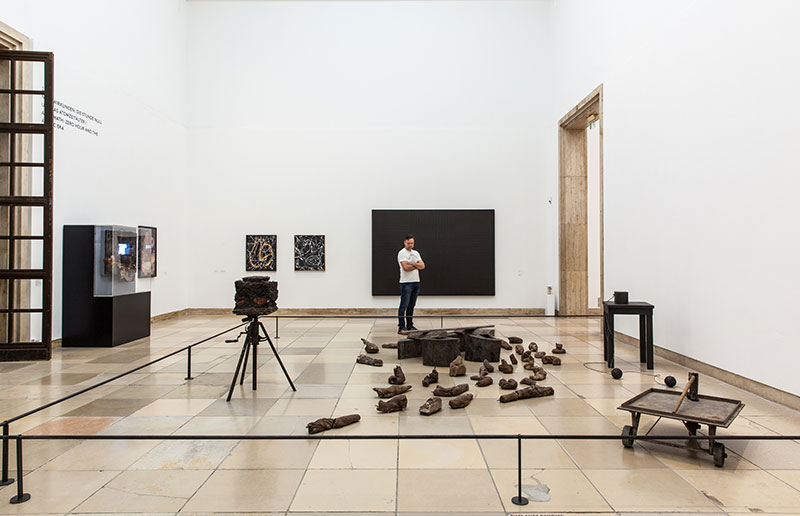
Thus this small first room by which you enter the exhibition is a prologue; it prepares you for how Postwar works. A wall behind Hirschdenkmaler blocks a long view into the main gallery space, foreclosing any sense of spectacle and keeping your attention on the assemblage spread at your feet. This immediately positions you as a participant not a viewer. Indeed, you will trip over Hirschdenkmaler’s low protecting barrier if you move too quickly through its entrance.
Protruding well into the traffic flow, Hirschdenkmaler forces viewers abruptly left or right. But I was distracted by a German voice immediately behind me. Despite the lack of room and seating, for the next hour I was transfixed by a black and white television interview made in 1964 with a chain-smoking Hannah Arendt. Her thoughtful responses to the climate of the immediate postwar period were compelling. What one commentator said of the interview aptly described the exhibition: “Here is what thinking looks like. It’s slow and deliberative, not sharp and declarative, moving in circles, not straight lines.”[2]
After listening to Arendt I entered the room on the right, which plunges you into the horror of Nagasaki, 9–10 August 1945. Tellingly, the army documentation is more powerful than the art, confirming Adorno’s aphorism that there can be no poetry after Auschwitz. The only way out is back from where you came. From here there are two choices: veer left of Hirschdenkmaler, past Gerhard Richter’s painting of American bombers dropping their load and on through US Abstract Expressionist works; or veer right of Hirschdenkmaler, past Richter’s painting of a funeral and on through the abstract expressionism of Japanese Gutai artists.
.jpg)
Either way, you are quickly disorientated by an impressive array of angled walls that cut into the large central gallery of the exhibition. Splitting to the left and right, they create diagonal sight lines, some of which deliver short but exhilarating aesthetic narratives in which art from the centre and periphery cross, before dissipating into a few small rooms towards the back of the hall. Then the main stream divides again, carrying you through to the rear and back down the rooms on each side of the central hall to the entrance. Thus the Haus der Kunst is made to feel more like a bazaar than the temple (to German art) Hitler intended it to be.
The momentum established at the beginning of this exhibition frays the further you get into it, dispersing into its labyrinthine canyons. This diffused decentred untidy layout, which echoes that of Hirschdenkmaler, provides a telling contrast with the hierarchical clarity of late modernism’s dominant centre/periphery model. Yet it is difficult not to view the Western “masterpieces” – many of which are large – by Beuys, Bacon, Pollock, de Kooning, Rauschenberg and Warhol as benchmarks against which to measure the other art. Postwar heightens the centre/periphery fault lines of this period, but it obscures their ideological function. Thus late modernism’s “provincialism problem” is an unresolved undercurrent in the exhibition. The 15% participation rate of women will also seem a blind spot – at least to half the viewers – even though the curators have sought to include female artists, and this rate is high for most exhibitions devoted to the period.
The big blind spot in Postwar is indigenous not women artists. Mawalan Marika, a Yolngu man from northern Australia, is the only indigenous artist included – unless one counts African artists such as Twins Seven Seven or even Susanne Wenger – the Austrian Yoruban priestess who went well beyond the indigenism (the assimilation of indigenous imagery into nationalist discourses by non-indigenous artists) that is canvassed elsewhere in the exhibition. African American artists feature extensively in Postwar, so why are Native American artists absent? Any number would have deepened its currents: Joe Herrera, George Morrison, Alex Janvier – perhaps even Yeffe Kimball who during this period successfully invented for herself a Native American (Osage) identity. She even made a mushroom cloud sculpture inspired by a piece of fused earth from nuclear tests that her husband (a physicist who worked on the Manhattan Project) possessed.

Further, Pacific Islanders are not represented despite “Pacific” being in the exhibition’s title. Postwar would have benefited from the inclusion of Maori modernists such as Ralph Hotere, Para Matchitt and Selwyn Wilson, and their Pakeha counterparts, New Zealand indigenists such as Colin McCahon and Gordon Walters.
Australia can count itself lucky to be represented by three works. Weaver Hawkins’s Atomic Power (1947) was included because of its subject (it depicts a mushroom cloud), but Albert Tucker’s abject style would have resonated better in this exhibition. He was also in Hiroshima working as a war artist 18 months after the devastating explosion. Ian Fairweather is another likely candidate for Postwar. A student at London’s School of Oriental Studies and the Slade School of Fine Art in the 1920s, both his mid-twentieth century nomadic life in Asia and Australia and cross-cultural painting style have the requisite grunge factor.
Tony Tuckson’s Black Woman, half length, 1956, comes off well in the conversations occurring in the room devoted to “New images of man”. But Marika’s small ochre painting on bark – Sydney from the air, 1963 – is misplaced, wedged between two large US Pop art paintings in a room devoted to racial violence and civil unrest.
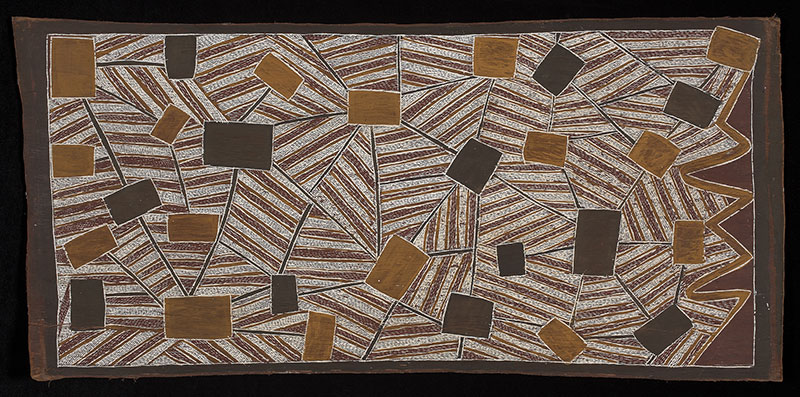
Marika is a good candidate for this exhibition. Yirrkala – a remote village where he was the leading painter – was a forward airbase in the war, and for a while on the frontline. Marika played a pivotal role in the war effort and the postcolonial land rights movement at Yirrkala that emerged afterwards. As the only indigenous artist from a settler colony in the exhibition, the curators seemed unable to find a suitable seat for him at the table. They should have listened to Karel Kupka (from André Breton’s circle), who in the early 1960s commissioned work from Marika and noted the affinity between abstract bark paintings such as this, and contemporary European concrete art.[3] Marika’s bark would have been better placed with Erhabor Emokpae’s striking board from the same year, Struggle Between Life and Death, in the thematic section “Concrete Visions”.
There are so many stories in Postwar that the few missteps are minor ripples that have no real impact on the larger currents in which it operates. Some might think Postwar is long overdue, which it surely is, but it will be remembered as an exhibition for our time – not definitive but the best mud map we have for a new myth of late modernism that better explains our current heading.
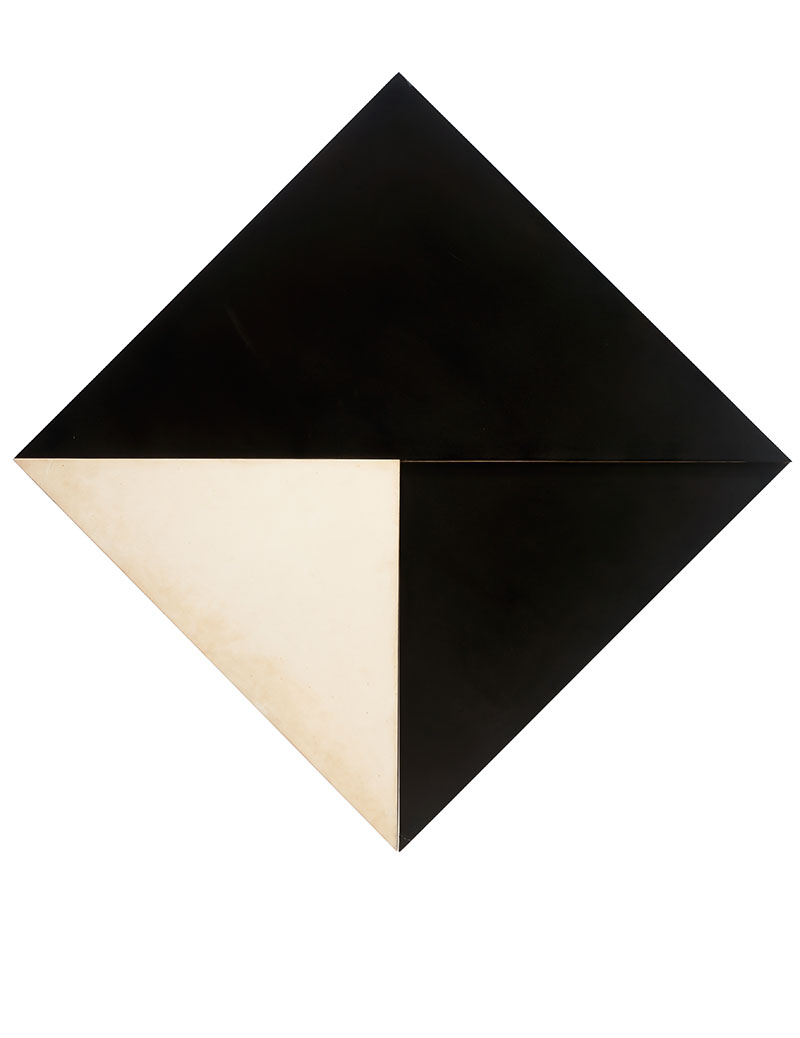
Footnotes
- a, b Hitler’s Speech at the Opening of the House of German Art in Munich, 18 July 1937: http://germanhistorydocs.ghi-dc.org/sub_document.cfm?document_id=1577
- ^ ‘This is what thinking looks like (Gunter Gaus interviews Hannah Arendt)’: https://jewishphilosophyplace.wordpress.com/2013/06/06/this-is-what-thinking-looks-like-gunter-gaus-interviews-hannah-arendt-1964/. The interview can be seen at: https://www.youtube.com/watch?v=dsoImQfVsO4.
- ^ Karel Kupka, Dawn of Art: Painting and Sculpture of Australian Aborigines, Sydney: Angus & Robertson, 1965, at 99.

